Houston, we have a problem, and for some reason, it seems to be located all over the brown sea you call your backyard.
With streams of thick brown gunk overtaking your once green grass, it’s clear that your lawn needs some help battling its watery foe, and you’re eager to lend a hand.
But, besides practically swimming to its melting center, what can you really do to aid the marsh erupting in the back of your house?
Fear not, because unfortunately, a muddy backyard winds up being an unwelcome and unanticipated problem for a great number of homeowners. You’ve done everything within reason to create a landscape you take pride in, but amid the revelry, you have encountered an insidious muddy mess.
Make sure that if you have trees in your yard, you are providing them the proper care. Check out our Chinese elm tree comprehensive care guide here on the Green Pinky.
Nothing can rain on your parade quite like, well, rain — or an irrigation system if you ignore the contours of your landscape
Despite all your efforts at creating an ideal scene around your house, every time water saturates the turf, you wind up with a soggy, muddy mess.
Your soil is sodden, and your grass is drowning.
Why does water seem to collect and create a muddy yard? Is there anything you can do or use to drain or remedy this soddy circumstance in your lawn or garden? Fortunately, there are always solutions to the problems that a muddy yard creates.
Read on to get in on the solutions that will surely address the problems that muddy backyards create while also supporting the overall health of your grass and other plants.
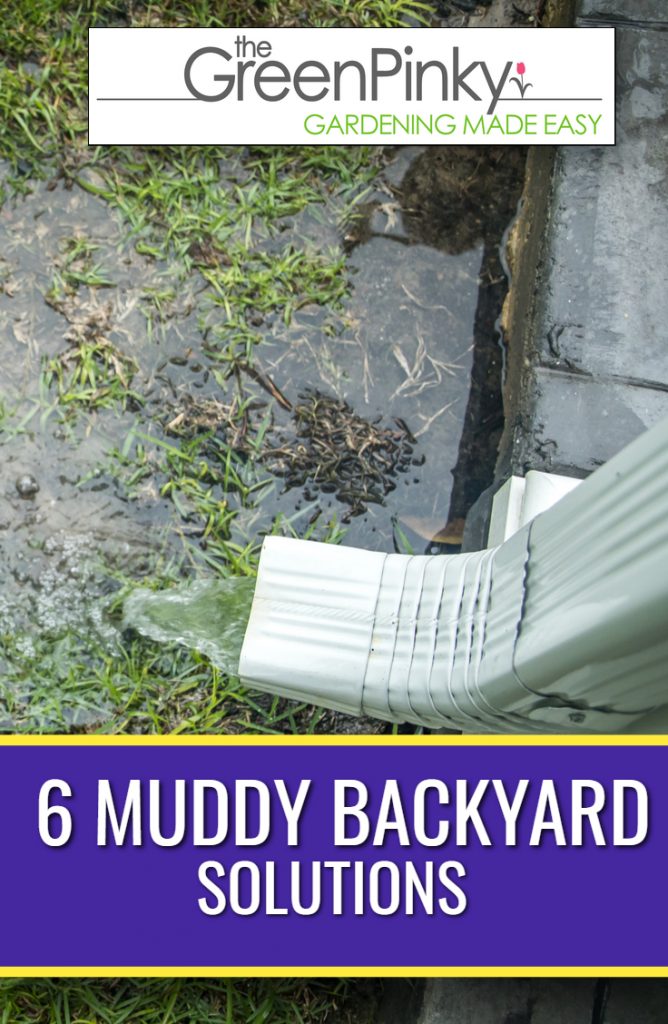
Why Do Yards Hold Water?
The first and most obvious answer to this question doubles as the root cause of the problem: natural precipitation. You are highly likely to experience torrential downpour or heavy rain from a thunderstorm at some point during the year, and mother nature does not operate using a flow controller like your irrigation system.
When faced with this issue, it’s important not to panic. So, before you go running out into your muddy lawn and upending your landscape, keep reading to learn the most pressing causes for your messy backyard.
The water your lawn and garden receives as the result of rain is considerably more than your ground requires. So, it should not surprise you that your lawn may need more time to properly drain and dry off after long, pronounced periods of rainfall.
Do not be alarmed if it doesn’t drain quickly. You shouldn’t consider these circumstances an emergency unless the water remains standing long after a normal drainage period. If you find this is the case, you need to inspect the issue a bit more closely.
Below are a few of the major culprits of your lawn or garden not draining correctly.
Bad Elevation
Have you noticed that water collects and stands around the foundation outside of your house? This drainage issue is most likely due to poor elevation at the foundation of your home.
Poor elevation is the most common drainage issue that homeowners face today. Left unresolved, it will cause problems with the floors and drywall of your home. It can even damage the entire foundation of your house.
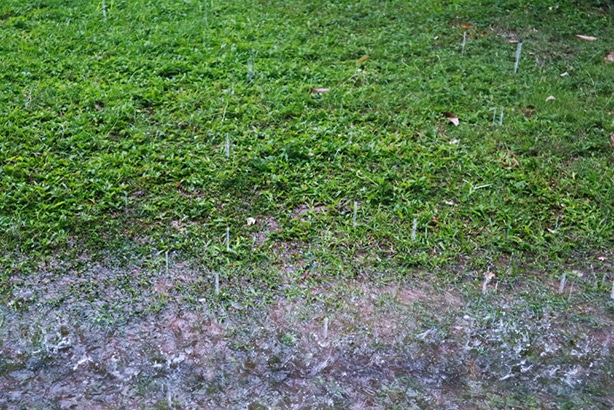
Landscape Design
If you decided to hastily throw together a quick landscape design without understanding the natural order of the ground around your house, then you may have unknowingly created a drainage issue that you will have to fix.
You’ll notice that no matter how much or how little you water your plants, water will pool up around them without fail. This is because you may have impeded the natural flow of water over the ground by haphazardly placing your flower beds in a particular spot. By accident, you have prevented the water from flowing in the direction that it was naturally meant to go.
Impeding this natural flow causes the water to pool in and around your plants’ beds. This standing water can kill your plants if something is not done to restore the natural flow of water through your backyard.
Water Traps
You may have noticed that water is pooling inexplicably in random areas throughout your muddy backyard. This drainage problem is due to the ground not being adequately graded, which causes these depressions in your backyard.
Think about potholes in a road if you are having trouble grasping this concept. These “potholes” in your backyard fill with water and will create an environment like a swamp or marsh around your house.
Standing, stagnant water like this will then kill off any plant life you are attempting to grow in these areas.
Paved Concrete Surfaces
If your concrete or hardscaped surface was installed incorrectly, it can also be an area of your property where water will not drain.
For a concrete surface such as a driveway, this soggy problem most likely arises because the concrete was not graded correctly during installation. This is unfortunate because the only way to correct the issue is to demolish the concrete structure and start over.
If you choose to use materials that are more temporary than concrete, such as paving stones, bricks, rocks, gravel, or mulch, it is essential that you grade the surface they will rest on ever so slightly.
If this slope is not used, it will cause the area near your home not to drain.

Make sure to also read our article on getting rid of clover. Don’t let these pesky weeds take over your lawn.
Gutter Downspouts
Properly maintained and cleaned, a gutter system covering the drip edges of the roof of your home is a wonderful investment. However, if you do not clean and maintain your gutters, then the downspouts may become blocked and cause the water to fill the inside the gutter trough. Eventually, the gutter channel will fill to capacity and overflow into your yard instead.
This overflow can saturate a specific area and wash away ground and soil, causing the water to collect and stand right on top of the plants you place in that position.
You should also note that gutters can be a two-fold issue despite all the benefits they provide.
Even if you clean and maintain your gutter system, the areas in which the downspouts deposit the rainwater into your yard can prove to be an issue.
The location where the downspouts end can pour large amounts of water onto a vital place in your yard. These can be areas like an entryway to your house, areas of flower beds, or spots of vulnerable areas of grass that may not drain well.
Soil Compaction
Soil compaction occurs when the ground in your yard is used heavily for work or play. Soil is compacted when the small spaces between the soil particles have been greatly diminished and the water has nowhere to go. The result is a wet, soggy, and muddy yard.
Soil compaction problems depend on the consistency of the soil in your yard. If the soil of the ground in your yard has a high percentage of sand, then the odds of having compacted soil are relatively low.
If your ground is made up of clay or loamy dirt, you may experience a higher rate of compaction.
Thatch in Your Lawn
Thatch is organic debris on your yard that makes its home in the area between the green vegetation on the top and the dirt’s surface below. Some examples of this organic debris include, but are not limited to, grass clippings, stems, shoots, leaves, and roots.
For your lawn to drain correctly, the water must absorb into the ground. Thatch can make this more difficult due to the accumulation of this organic matter.
Instead of the water soaking into the soil, it will pool on top of the organic matter and create a muddy yard.

Hardpan
The consistency and compaction of the topsoil are not the only items to consider when looking at the earth beneath your feet. You must also take into consideration the subsoil that lies immediately beneath the layer of topsoil.
Hardpan is a dense, thick subsoil that is essentially impervious to water. Hardpan can occur naturally or can be created accidentally underneath the wheels of construction vehicles.
The hardpan may only be a few inches beneath the topsoil, which is problematic in terms of the drainage capabilities of your yard.
If the hardpan layer is only a few inches from the surface of the ground, the water may soak through the layer of topsoil and pool on top of the hardpan layer that is only a very short distance beneath the surface of your yard.
Water Table is too High
One reason people still dig wells today is because the earth is saturated with water deep under the ground. The depth of this saturation is what is known as the water table.
The water table is deeper in some spots than it is in others. If your water table is too close to the surface, it may be difficult for the water to drain because it has nowhere else to go.
6 Tips for Fixing a Muddy Lawn
Now that you know the primary reasons why your yard becomes inundated with mud and water, let’s consider a few different solutions that will fix a muddy yard. Solutions like these have been tested and proven to succeed time and time again.
These muddy yard solutions include:
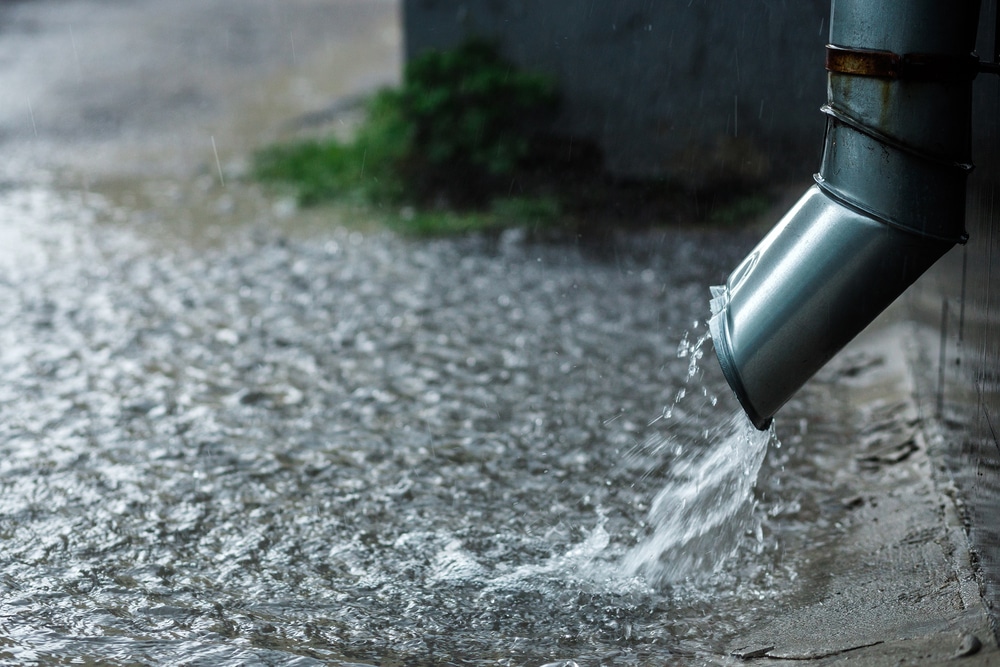
1. Extend Gutter Downspouts
This is an easy fix if you have found that water is pooling near your home’s foundation.
Often, your gutter system will deposit rainwater at the foundation’s corners. If you have found these spots filled with mud and water, you probably have a problem with the grading of your ground. By installing extensions to your downspouts, you divert the rainwater away from the foundation of your home.
Installing a catch basin for the water is also a relatively quick solution whether you extend the downspouts or not. These two solutions go hand in hand when trying to fix drainage issues in your yard.
2. Install a French Drain
When you begin considering how to fix the problem of standing water in your muddy yard, you have no doubt run across the term “French drain.”
A French drain is a flexible plastic drainpipe that is placed underneath your lawn to help channel water away. To install this, you must first identify the area in your yard where the water pools.
Use a shovel to dig a trench that leads to a place where the water can drain more easily. Once you have completed digging the trench, you need to line it with pea gravel.
Take your French drain — if you use a standard landscape drainpipe, you need to perforate it with holes — and wrap it in landscape fabric. When covering the pipe, you should leave both ends of the pipe open to encourage draining.
After you have wrapped the pipe, you should place it on the top of the pea gravel that you have spread through the trench. Finally, cover the pipe with additional pea gravel. The pea gravel is used to supplement the ease of the water percolating and draining to the pipe.
A French drain is one of the most common and basic ways to keep water from standing on the grass.
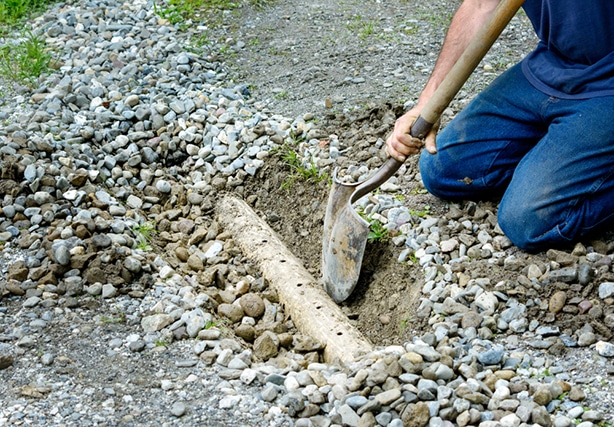
3. Check Your Grade
Your yard may experience pooling due to the common issue of improper grading.
Your lawn should slightly slope away from your house to encourage the water to flow away from the foundation. You can use a yardstick and a tape measure to quickly check the grade of your lawn.
Have someone hold the tape measure (if someone is not available, you can use a screwdriver to pin the tape measure into the soil) where the foundation meets the soil. Then use the tape measure to measure 10′ away from the foundation. While holding the tape measure level, place the yardstick on top of the turf at the 10′ mark.
Ideally, you should see that your mark is at least 6″ lower than your foundation. If it is not 6″ or more, you need to correct the grade of your yard.
A quick solution to fix a muddy yard with an improper grade is to use mulch to build up your flower beds. The mulch will add height near your house’s foundation so that it slopes at a greater angle. The mulch will also soak up some of the excess water and hold it there, which is healthy for the plants in your flower beds.
4. Create a Creek Bed
Using this tactic can add an aesthetic touch that is also a functional solution to a muddy yard.
You start by creating a gentle and shallow drainage ditch called a swale. Then you line the swale with rocks to define its shape. The rocks can also act as a barrier for any run-off or erosion you might experience. If you prefer, you can use mulch to create the banks for the creek bed.
Utilizing this solution will also add beauty to your property even when it is dry.
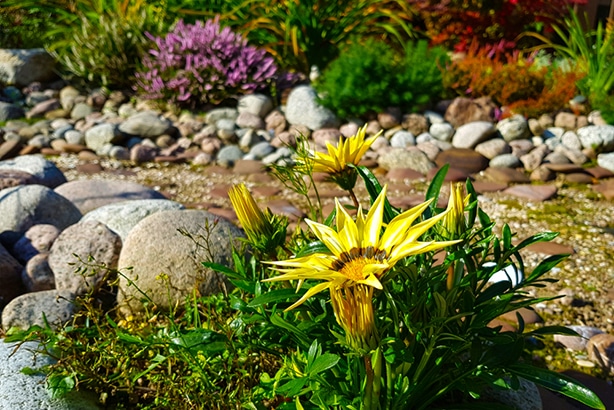
5. Create a Rain Garden
If you choose to create a creek bed, you could also install a rain garden for the water you have diverted with the creek bed to flow into.
Simply put, this is an area of your yard designed to catch rainwater and is filled with plants that have an affinity for excessive moisture. Make sure you do a little research for the right kind of plants.
While this solution doesn’t fix a muddy yard problem, it does look better than just having a muddy yard.
6. Dig a Dry Well
If you don’t have the time or the inclination to build a rain garden, you can dig a dry well.
A dry well creates a spot for the run-off to go and then soak back into the soil. You should arrange the rocks of the creek bed to flow into the well and then absorb into the soil under the ground. This will prevent pooling on the top of the turf.
To keep safe, you need to install a grate over the open hole of the well.

